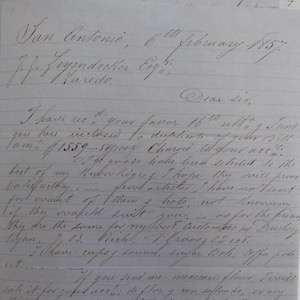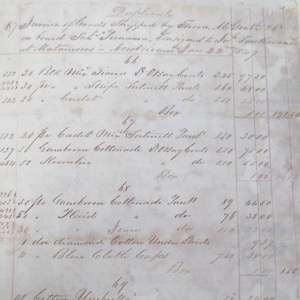Short Teaching Module: Connecting Local and Global History via Mercantile Networks
Overview
European merchants spread throughout the world seeking new markets. In doing so, they actively connected remote localities to global networks across multiple continents. Local people around the world often challenged European economic dominance, forcing European merchants to pursue accommodating relationships with local people. We can see these processes within the isolated U.S.-Mexico borderlands along the Lower Rio Grande in mid-nineteenth century through a bevy of primary sources, but particularly in invoices and private letters. Using various strategies, European merchants built massive networks that tied localities into global webs of exchange.
Essay
Merchants and traders throughout the world have long pursued network connections in order to expand their trade and ensure access to markets and commodities. By the nineteenth century, European merchants migrated into nearly every part of the world to assert their economic dominance. In doing so, they created growing interconnectedness and uniformity. Some merchants adopted strategies that combined trade with the use of force to disrupt regional power structures and establish a European ruling class, part of what Sven Beckert calls, “war capitalism” (Sven Beckert, Empire of Cotton: A Global History). However, local people often challenged, remolded, and set limits to European economic dominance (C.A. Bayly, The Birth of the Modern World: 1780-1914). This dynamic relationship forced many European merchants to pursue accommodating relationships with local people. Sometimes, they constructed strong networks among the regional elite and then connected those to broader global systems. At other times, they brought their pre-existing global networks to isolated regions and slowly integrated these localities through trade and credit agreements. Regardless of strategy, European merchants built networks that tied localities into global webs of exchange.
The Rio Grande borderlands between the United States and Mexico marked a region where European merchants had to pursue compromise and network building in order to draw the area into European markets. In the Rio Grande borderlands, European networks were in a perpetual state of construction because merchants had to constantly negotiate and seek allies in order to overcome internal and external disturbances that threatened their ties. Merchants had to form and dismantle their networks based on changing factors that included both human and non-human hazards (Bruno Latour, Reassembling the Social: An Introduction to Actor-Network Theory). From their neighbors to folks half a world away, European-born merchants assembled and reassembled complex social chains to stay connected.
One strategy to maintain stable networks was to bring global systems to bear on the local problem. Many of the European merchants who moved to the Rio Grande borderlands came from mercantile backgrounds with strong connections in Europe. They had a network of suppliers with trusted relationships who could provide a glut of products on easy credit terms, giving the merchant ample time to build a customer base. For example, Spanish-born José San Román dealt his products to regional merchants with equally easy credit terms. This strategy presented risks of nonpayment. However, the benefits could be lucrative. He not only earned interest on the credit agreements that paid off, but also learned who was trustworthy, locally. After a second round of credit, European merchants could begin to tap their customers for information, including word on deadbeats in nonpayment and connections to other trustworthy customers. Using this strategy, José San Román and others like him became essential nodes in the movement of both goods and financing throughout the borderlands.
Another strategy was to build tightly knit community connections and then link that provincial web to larger networks. French-born John Decker married into a prominent Mexican family in Camargo, Mexico then opened a merchant house across the river in Rio Grande City. He ingratiated himself with the Mexican community around Rio Grande City and Camargo to build a market selling textile products. As his business expanded, Decker needed to draw loans from larger merchants, as there was no bank in the borderlands at the time. He began by taking small loans from other merchants who worked with José San Román. Instead of paying back his lenders directly, Decker remitted payment to their accounts with San Román, thus building a reliable reputation with the Spanish merchant. After Decker demonstrated his reliability, he was able to integrate into the larger San Román network and draw on the Spaniard’s access to Atlantic credit systems.
Similarly, German-speaking John Z. Leyendecker provides another example of how a European merchant used marriage and the construction of regional kinship networks to build a transnational business in the Rio Grande borderlands. When he moved to Laredo, Leyendecker developed connections with prominent townsfolk. Through the friendship he developed with his landlord, Leyendecker expanded his network to include the Benavides family. He became business partners with Santos Benavides and married Santos’s sister, María Andrea. With the family’s economic resources, social connections, and political influence behind him, Leyendecker reached out to larger French and Dutch merchants in San Antonio and New Orleans. He exploited his access to the ranching elite in the borderlands to ship out agricultural products, mainly hides and corn, in exchange for European textiles.
These examples show how European merchants used multi-layered, interconnected systems to link an isolated locality to broader commercial networks. As with all network builders, they had to work constantly to maintain their relationships. In doing so, these Europeans persevered within the American borderland to bring the local closer to the global.
Primary Sources
Credits
Kyle B. Carpenter is a History Instructor at the University of Arkansas Rich Mountain. He received his Ph.D. in History from Southern Methodist University in May 2020. His book manuscript explores how European entrepreneurs tried to transform the Rio Grande borderlands from a regional crossroads of trade to a hub of the Atlantic economy.

